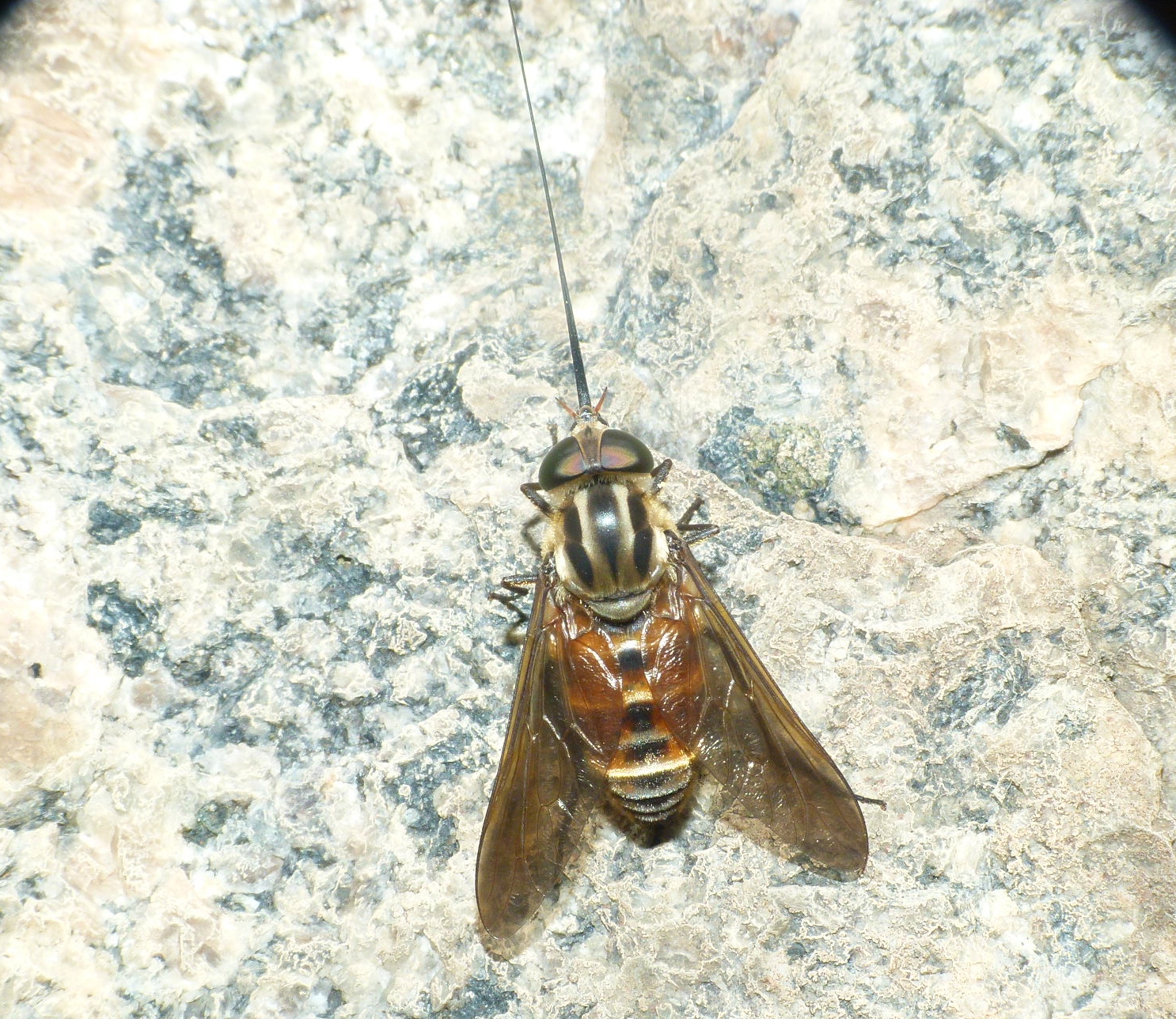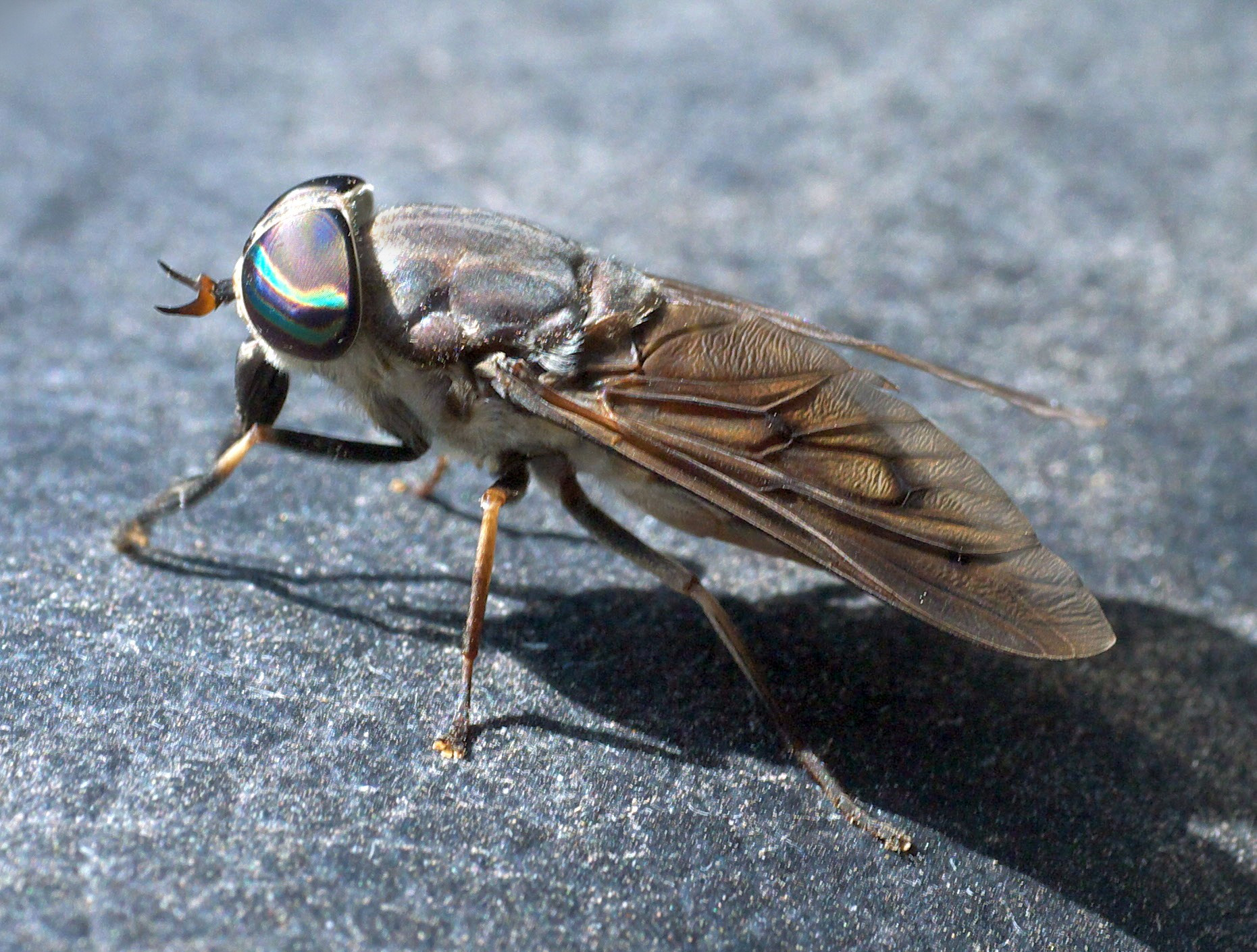|
Tabanidae
Horse-flies or horseflies are true flies in the family Tabanidae in the insect order Diptera. They are often large and agile in flight, and only the female horseflies bite animals, including humans, to obtain blood. They prefer to fly in sunlight, avoiding dark and shady areas, and are inactive at night. They are found all over the world except for some islands and the polar regions (Hawaii, Greenland, Iceland). Both horse-flies and botflies (Oestridae) are sometimes referred to as gadflies. Adult horse-flies feed on nectar and plant exudates; the males have weak mouthparts and only the females bite animals to obtain enough protein from blood to produce eggs. The mouthparts of females are formed into a stout stabbing organ with two pairs of sharp cutting blades, and a spongelike part used to lap up the blood that flows from the wound. The larvae are predaceous and grow in semiaquatic habitats. Female horse-flies can transfer blood-borne diseases from one animal to anoth ... [...More Info...] [...Related Items...] OR: [Wikipedia] [Google] [Baidu] |
Tabaninae
Tabaninae is a subfamily of horse flies in the family Horse-fly, Tabanidae. There are more than 3000 described species in Tabaninae. Tribes and genera Diachlorini *''Acanthocera'' Pierre-Justin-Marie Macquart, Macquart, 1834 *''Acellomyia'' Gonzalez, 1999 *''Anacimas'' Günther Enderlein, Enderlein, 1923 *''Anaerythrops'' Barretto, 1948 *''Atelozella'' Joseph Charles Bequaert, Bequaert, 1930 *''Atelozomyia'' Dias, 1987 *''Bartolomeudiasiella'' Dias, 1987 *''Bolbodimyia'' Jacques-Marie-Frangile Bigot, Bigot, 1892 *''Buestanmyia'' González, 2021 *''Catachlorops'' Adolfo Lutz, Lutz, 1909 *''Chalybosoma'' Harold Oldroyd, Oldroyd, 1949 *''Chasmia'' Günther Enderlein, Enderlein, 1922 *''Chlorotabanus'' Adolfo Lutz, Lutz, 1909 *''Cretotabanus'' Graham Fairchild, Fairchild, 1969 *''Cryptotylus'' Adolfo Lutz, Lutz, 1909 *''Cydistomorpha'' Trojan, 1994 *''Cydistomyia'' Taylor, 1919 *''Dasybasis'' Pierre-Justin-Marie Macquart, Macquart, 1847 *''Dasychela'' Günther Enderlein, Enderlein, ... [...More Info...] [...Related Items...] OR: [Wikipedia] [Google] [Baidu] |
Chrysopsinae
Chrysopsinae is a subfamily of deer flies in the family Tabanidae. Genera These 33 genera belong to the subfamily Chrysopsinae: *'' Aegophagamyia'' Austen, 1912 *'' Alocella'' Quentin, 1990 *'' Betrequia'' Oldroyd, 1970 *''Chrysops'' Meigen, 1803 *'' Eucompsa'' Enderlein, 1922 *'' Gastroxides'' Saunders, 1842 *'' Gressittia'' Philip & Mackerras, 1960 *'' Jashinea'' Oldroyd, 1970 *'' Mackerrasia'' Travassos Dias, 1956 *'' Melissomorpha'' Ricardo, 1906 *'' Merycomyia'' Hine, 1912 *'' Nemorius'' Rondani, 1856 *'' Neochrysops'' Walton, 1918 *'' Oldroydiella'' Travassos Dias, 1955 *'' Orgizocella'' Quentin, 1990 *'' Orgizomyia'' Grünberg, 1906 *'' Paulianomyia'' Oldroyd, 1957 *'' Phibalomyia'' Taylor, 1920 *'' Pseudopangonia'' Ricardo, 1915 *'' Pseudotabanus'' Ricardo, 1915 *'' Rhigioglossa'' Wiedemann, 1828 *''Rhinomyza'' Wiedemann, 1820 *'' Seguytabanus'' Paulian, 1962 *'' Silviomyza'' Philip & Mackerras, 1960 *'' Silvius'' Meigen, 1820 *'' Sphecodemyia'' Austen, 1937 ... [...More Info...] [...Related Items...] OR: [Wikipedia] [Google] [Baidu] |
Pangoniinae
Pangoniinae is a subfamily of Horse-flies in the order Diptera, containing at least four tribes and 24 genera. Insects in this subfamily are distinguished from other Tabanidae by possession of ocelli and the antennal flagellum usually has eight rings. Tribes and Genera Goniopsini Tribe Goniopsini Lessard, 2014 *'' Goniops'' Aldrich, 1892 Mycteromyiini *'' Caenopangonia'' Kröber, 1930 Pangoniini Many Neotropical Tribe Pangoniini *'' Apatolestes'' Williston, 1885 *'' Asaphomyia'' Stone, 1953 *'' Austroplex'' Mackerras, 1955 *'' Brennania'' Philip, 1941 *'' Caenoprosopon'' Ricardo, 1915 *'' Ectenopsis'' Macquart, 1838 *'' Esenbeckia'' Rondani, 1863 *'' Nagatomyia'' Murdoch & Takashasi, 1961 *'' Pangonius'' Latreille, 1802 *'' Pegasomyia'' Burger, 1985 *'' Protosilvius'' Enderlein, 1922 *'' Stonemyia'' Brennan, 1935 *'' Therevopangonia'' Mackerras, 1955 Philolichini Tribe Philolichini *'' Philoliche'' Wiedemann, 1920 Scionini Tribe Scionini *'' Anzomyia'' Lessar ... [...More Info...] [...Related Items...] OR: [Wikipedia] [Google] [Baidu] |
Tabanus Sulcifrons
''Tabanus sulcifrons'' is a species of horse fly in the family Tabanidae Horse-flies or horseflies are true flies in the family Tabanidae in the insect order Diptera. They are often large and agile in flight, and only the female horseflies bite animals, including humans, to obtain blood. They prefer to fly in s .... Subspecies These two subspecies belong to the species ''Tabanus sulcifrons'': * ''Tabanus sulcifrons sulcifrons'' Macquart, 1855 * ''Tabanus sulcifrons variegatus'' Fabricius, 1805 References Tabanidae Insects described in 1855 Diptera of North America Taxa named by Pierre-Justin-Marie Macquart {{tabanoidea-stub ... [...More Info...] [...Related Items...] OR: [Wikipedia] [Google] [Baidu] |
Adersiinae
''Adersia'' is a genus of horseflies of the family Tabanidae. It is the only genus in the tribe Adersiini, and the only member of the subfamily Adersiinae. Species *'' Adersia ambigua'' Oldroyd, 1957 *''Adersia callani ''Adersia'' is a genus of horseflies of the family Horse-fly, Tabanidae. It is the only genus in the tribe Adersiini, and the only member of the subfamily Adersiinae. Species *''Adersia ambigua'' Harold Oldroyd, Oldroyd, 1957 *''Adersia callani' ...'' Oldroyd, 1957 *'' Adersia gandarai'' Dias, 1959 *'' Adersia guichardi'' Oldroyd, 1957 *'' Adersia maculenta'' (Dias, 1956) *'' Adersia oestroides'' ( Karsch, 1888) References {{Taxonbar, from=Q14742489 Tabanidae Brachycera genera Taxa named by Ernest Edward Austen Diptera of Africa ... [...More Info...] [...Related Items...] OR: [Wikipedia] [Google] [Baidu] |
Diptera
Flies are insects of the order Diptera, the name being derived from the Greek δι- ''di-'' "two", and πτερόν ''pteron'' "wing". Insects of this order use only a single pair of wings to fly, the hindwings having evolved into advanced mechanosensory organs known as halteres, which act as high-speed sensors of rotational movement and allow dipterans to perform advanced aerobatics. Diptera is a large order containing an estimated 1,000,000 species including horse-flies, crane flies, hoverflies and others, although only about 125,000 species have been described. Flies have a mobile head, with a pair of large compound eyes, and mouthparts designed for piercing and sucking (mosquitoes, black flies and robber flies), or for lapping and sucking in the other groups. Their wing arrangement gives them great maneuverability in flight, and claws and pads on their feet enable them to cling to smooth surfaces. Flies undergo complete metamorphosis; the eggs are often laid on the l ... [...More Info...] [...Related Items...] OR: [Wikipedia] [Google] [Baidu] |
Trypanosoma
''Trypanosoma'' is a genus of kinetoplastids (class Trypanosomatidae), a monophyletic group of unicellular parasitic flagellate protozoa. Trypanosoma is part of the phylum Sarcomastigophora. The name is derived from the Greek ''trypano-'' (borer) and ''soma'' (body) because of their corkscrew-like motion. Most trypanosomes are heteroxenous (requiring more than one obligatory host to complete life cycle) and most are transmitted via a vector. The majority of species are transmitted by blood-feeding invertebrates, but there are different mechanisms among the varying species. Some, such as '' Trypanosoma equiperdum'', are spread by direct contact. In an invertebrate host they are generally found in the intestine, but normally occupy the bloodstream or an intracellular environment in the vertebrate host. Trypanosomes infect a variety of hosts and cause various diseases, including the fatal human diseases sleeping sickness, caused by ''Trypanosoma brucei'', and Chagas disease, caused ... [...More Info...] [...Related Items...] OR: [Wikipedia] [Google] [Baidu] |
Red Deer
The red deer (''Cervus elaphus'') is one of the largest deer species. A male red deer is called a stag or hart, and a female is called a hind. The red deer inhabits most of Europe, the Caucasus Mountains region, Anatolia, Iran, and parts of western Asia. It also inhabits the Atlas Mountains of Northern Africa; its early ancestors are thought to have crossed over to Morocco, then to Algeria, Libya and Tunisia via the Strait of Gibraltar, becoming the only species of true deer (Cervidae) to inhabit Africa. Red deer have been introduced to other areas, including Australia, New Zealand, the United States, Canada, Peru, Uruguay, Chile and Argentina. In many parts of the world, the meat (venison) from red deer is used as a food source. Red deer are ruminants, characterized by a four-chambered stomach. Genetics, Genetic evidence indicates that the red deer, as traditionally defined, is a species group, rather than a single species, though exactly how many species the group includes rem ... [...More Info...] [...Related Items...] OR: [Wikipedia] [Google] [Baidu] |
Vikings
Vikings ; non, víkingr is the modern name given to seafaring people originally from Scandinavia (present-day Denmark, Norway and Sweden), who from the late 8th to the late 11th centuries raided, pirated, traded and settled throughout parts of Europe.Roesdahl, pp. 9–22. They also voyaged as far as the Mediterranean, North Africa, Volga Bulgaria, the Middle East, and North America. In some of the countries they raided and settled in, this period is popularly known as the Viking Age, and the term "Viking" also commonly includes the inhabitants of the Scandinavian homelands as a collective whole. The Vikings had a profound impact on the early medieval history of Scandinavia, the British Isles, France, Estonia, and Kievan Rus'. Expert sailors and navigators aboard their characteristic longships, Vikings established Norse settlements and governments in the Viking activity in the British Isles, British Isles, the Faroe Islands, Settlement of Iceland, Icela ... [...More Info...] [...Related Items...] OR: [Wikipedia] [Google] [Baidu] |
Old Norse
Old Norse, Old Nordic, or Old Scandinavian, is a stage of development of North Germanic languages, North Germanic dialects before their final divergence into separate Nordic languages. Old Norse was spoken by inhabitants of Scandinavia and their Viking expansion, overseas settlements and chronologically coincides with the Viking Age, the Christianization of Scandinavia and the consolidation of Scandinavian kingdoms from about the 7th to the 15th centuries. The Proto-Norse language developed into Old Norse by the 8th century, and Old Norse began to develop into the modern North Germanic languages in the mid-to-late 14th century, ending the language phase known as Old Norse. These dates, however, are not absolute, since written Old Norse is found well into the 15th century. Old Norse was divided into three dialects: Old West Norse, ''Old West Norse'' or ''Old West Nordic'' (often referred to as ''Old Norse''), Old East Norse, ''Old East Norse'' or ''Old East Nordic'', and ''Ol ... [...More Info...] [...Related Items...] OR: [Wikipedia] [Google] [Baidu] |
Pliny The Younger
Gaius Plinius Caecilius Secundus, born Gaius Caecilius or Gaius Caecilius Cilo (61 – c. 113), better known as Pliny the Younger (), was a lawyer, author, and magistrate of Ancient Rome. Pliny's uncle, Pliny the Elder, helped raise and educate him. Pliny the Younger wrote hundreds of letters, of which 247 survive, and which are of great historical value. Some are addressed to reigning emperors or to notables such as the historian Tacitus. Pliny served as an imperial magistrate under Trajan (reigned 98–117), and his letters to Trajan provide one of the few surviving records of the relationship between the imperial office and provincial governors. Pliny rose through a series of civil and military offices, the ''cursus honorum''. He was a friend of the historian Tacitus and might have employed the biographer Suetonius on his staff. Pliny also came into contact with other well-known men of the period, including the philosophers Artemidorus and Euphrates the Stoic, during his ... [...More Info...] [...Related Items...] OR: [Wikipedia] [Google] [Baidu] |
Micrographia Robert Hooke 24
''Micrographia: or Some Physiological Descriptions of Minute Bodies Made by Magnifying Glasses. With Observations and Inquiries Thereupon.'' is a historically significant book by Robert Hooke about his observations through various lenses. It was the first book to include illustrations of insects and plants as seen through microscopes. Published in January 1665, the first major publication of the Royal Society, it became the first scientific best-seller, inspiring a wide public interest in the new science of microscopy. The book originated the biological term ''cell''. Observations Hooke most famously describes a fly's eye and a plant cell (where he coined that term because plant cells, which are walled, reminded him of the cells in a honeycomb"... I could exceedingly plainly perceive it to be all perforated and porous, much like a Honey-comb, but that the pores of it were not regular .these pores, or cells, .were indeed the first microscopical pores I ever saw, and perhaps, ... [...More Info...] [...Related Items...] OR: [Wikipedia] [Google] [Baidu] |





_(10144905255).jpg)



